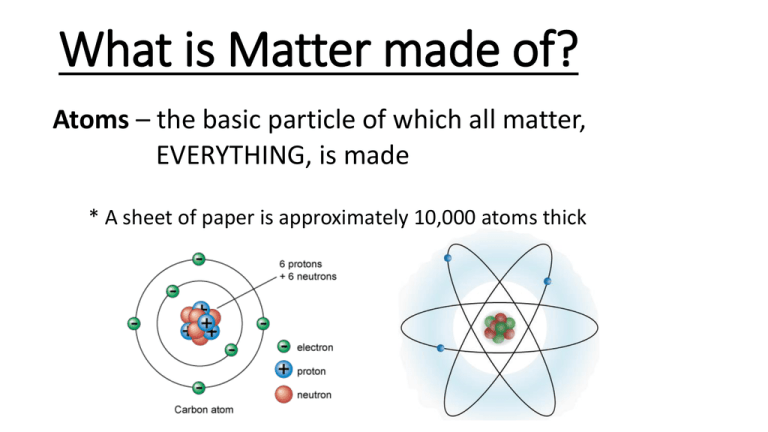At the core of physical science lies the understanding that matter is fundamentally constituted of atoms, which interact through various forces to form the myriad substances that populate our universe. However, the inquiry into whether a type of matter could exist that is not composed of atoms reveals a fascinating realm of theoretical physics and conceptual exploration. This discourse aims to elucidate the characteristics of different forms of matter and delve into the profound implications of non-atomic constructs.
To engage with this notion, it is essential to first ascertain what is meant by ‘matter.’ Traditionally defined, matter is anything that occupies space and possesses mass. It includes the tangible substances around us—solids, liquids, and gases—that are invariably formed by atoms. Each of these atoms, in turn, consists of protons, neutrons, and electrons. Yet, upon conducting a cursory investigation into the realms of cosmology and particle physics, we unveil the prospect that matter could transcend atomic structures.
One intriguing candidate for non-atomic matter resides in the domain of plasma. Plasma, often considered a fourth state of matter, is produced when enough energy is imparted to a gas that its atoms become ionized, resulting in a collection of free electrons and ions. While plasma is indeed comprised of ions, its physical characteristics and behaviors are markedly distinct from those of traditional atomic structures. The fascinating properties of plasma—such as its ability to conduct electricity and respond to magnetic fields—remind us that matter can manifest in forms that challenge our conventional understanding.
Beyond plasma, conceptual frameworks in theoretical physics present the possibility of matter that diverges even more significantly from atomic composition. Consider the hypothetical existence of dark matter—an enigmatic substance that constitutes approximately 27% of the universe’s total mass-energy content, yet eludes direct detection. Current astrophysical models suggest that dark matter does not interact with electromagnetic forces, diverging from atomic matter’s interactions. Instead, it exerts gravitational influences, thereby shaping cosmic structures such as galaxies. The nature of dark matter, largely theorized to consist of exotic particles like weakly interacting massive particles (WIMPs), raises profound questions about the fundamental constituents of the universe.
Furthermore, the potential existence of preons offers another tantalizing avenue for exploration. Preons are hypothetical elementary particles proposed as subcomponents of quarks and leptons, the building blocks of all atomic matter. If verified, this theory would suggest a layered structure of matter that undermines the atomic concept by positing constituents even more fundamental than atoms. Nevertheless, these notions are tempered by a lack of experimental evidence, leaving preons in a liminal state between speculative theory and future discovery.
As we transition our focus from exotic forms and particles to states of matter that are devoid of atomic structure, we encounter the phenomenon of vacuum energy. In quantum field theory, the vacuum state is not just an absence of matter but is instead teeming with virtual particles that spontaneously appear and annihilate. The implications of this vacuum state challenge our classical understanding of what constitutes ’empty’ space. Thus, while the vacuum may lack traditional matter, it is paradoxically rich in energy and potential.
There is a distinct fascination that lies in contemplating these non-atomic manifestations of matter. The universe operates on principles that are often counterintuitive and abstract. The intangible nature of concepts like dark matter or vacuum energy encapsulates the interplay between our observations and their underlying realities. This duality invites deeper inquiry into the essence of existence and the cosmos, eliciting a certain philosophical gravitas regarding our comprehension of reality.
Moreover, exploring non-atomic types of matter paves the way for potential practical applications. The unique characteristics of plasma have already garnered significant attention for their industrial applications, including their utilization in fusion energy research—an endeavor that promises a cleaner and more sustainable energy future. Similarly, unlocking the mysteries of dark matter could usher in revolutionary advancements in our understanding of gravitational forces and cosmic evolution.
The examination of matter not composed of atoms opens up an intellectual vista that transcends the limits of conventional material sciences. As researchers continue to peer into the depths of the microcosmic world and our vast universe, the line separating atomic from non-atomic matter blurs, engendering further questions and theories. In essence, the notion of matter without atoms not only enhances our scientific lexicon but also amplifies our sense of wonder and intrigue regarding the very fabric of existence.
In conclusion, the pursuit of understanding whether a form of matter exists beyond atomic composition is a journey laden with complexity and intrigue. From the ionized gas of plasma to the elusive nature of dark matter and the dynamic properties of vacuum energy, we are beckoned toward a multifarious landscape that challenges traditional paradigms. As humanity advances in its quest for knowledge, the potential revelations surrounding non-atomic matter inspire a deeper appreciation for the mysteries of the universe, reinforcing our relentless curiosity in the realms of physics and beyond.












